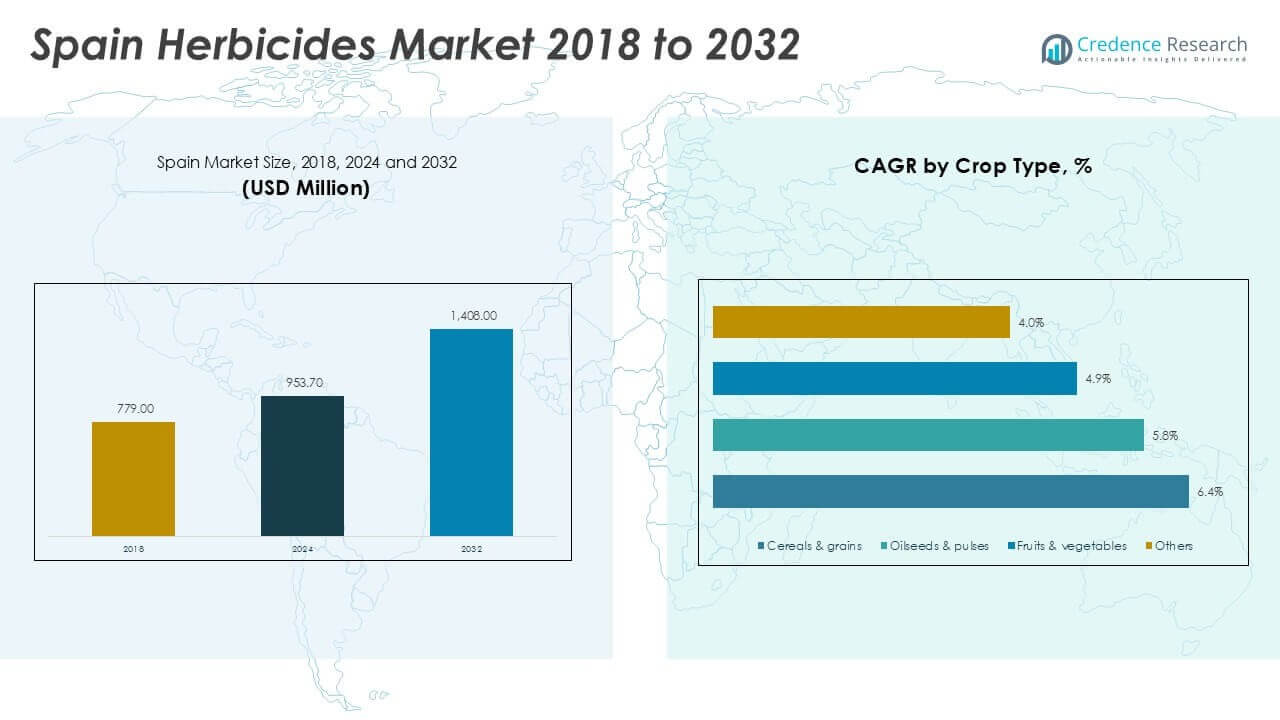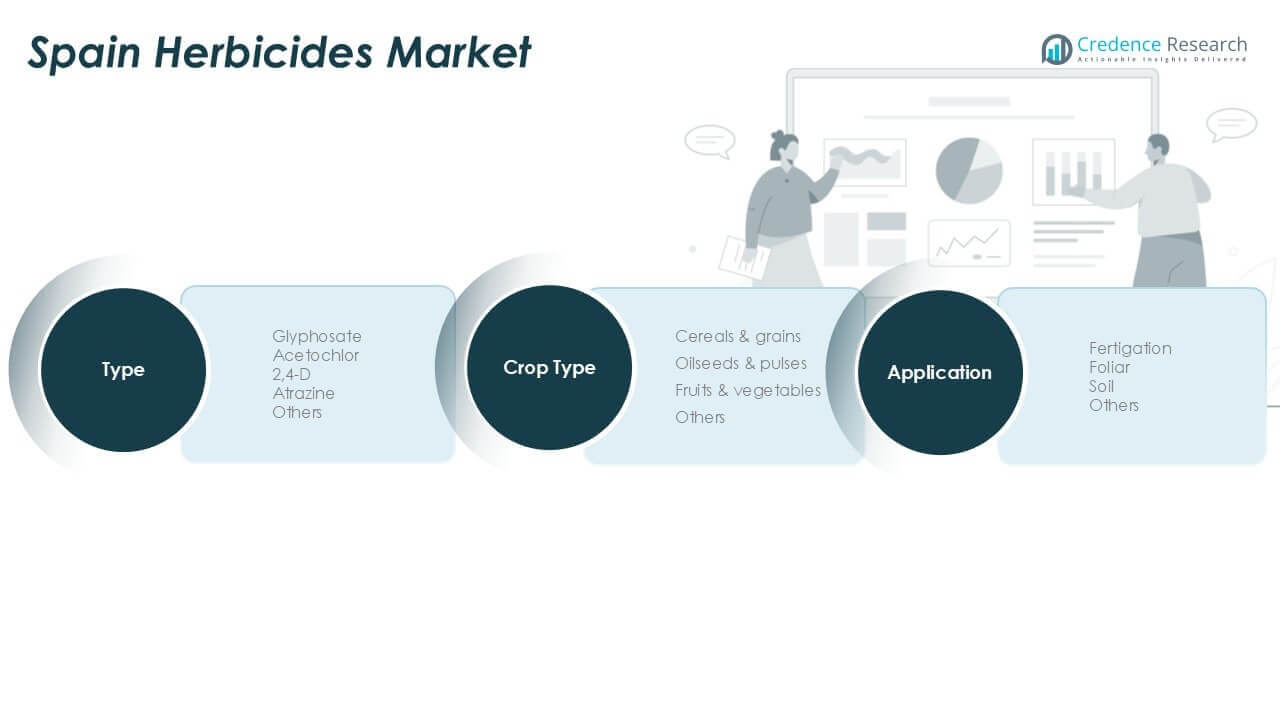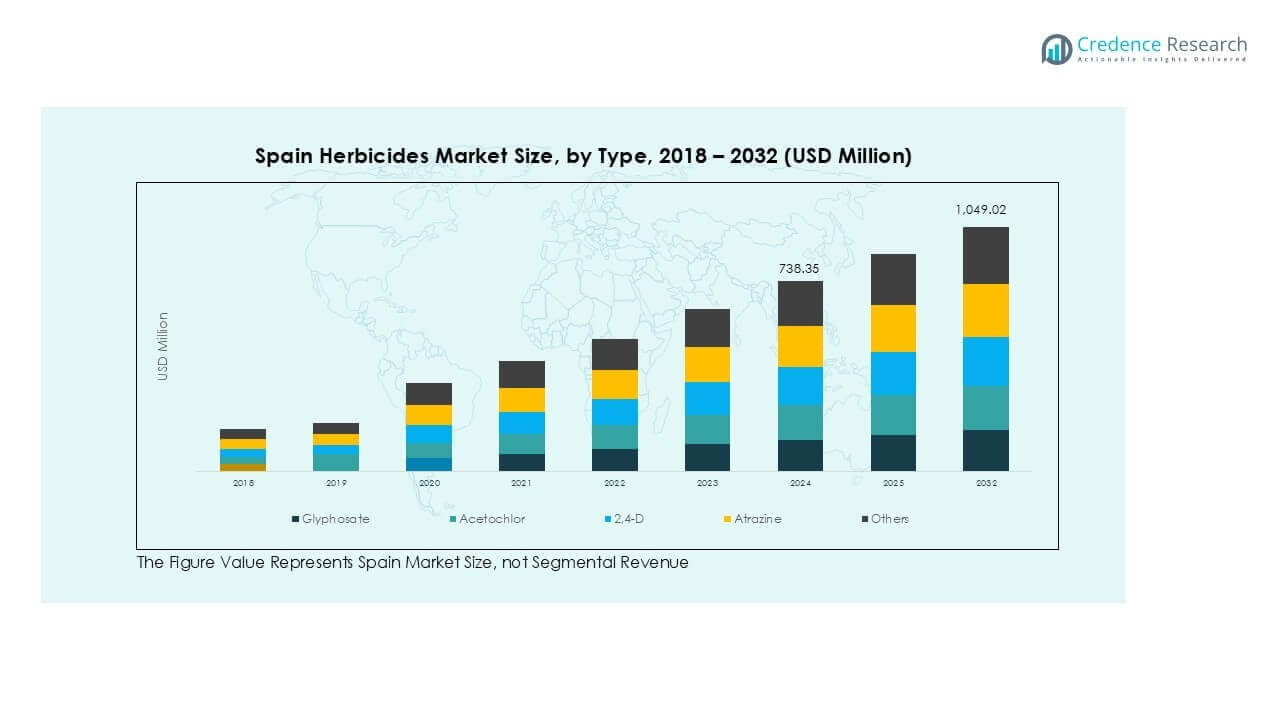Market Overview
Spain Herbicides Market size was valued at USD 635.36 million in 2018, reached USD 738.35 million in 2024, and is anticipated to reach USD 1,049.02 million by 2032, at a CAGR of 4.49% during the forecast period.
| REPORT ATTRIBUTE |
DETAILS |
| Historical Period |
2020-2023 |
| Base Year |
2024 |
| Forecast Period |
2025-2032 |
| Spain Herbicides Market Size 2024 |
USD 738.35 Million |
| Spain Herbicides Market, CAGR |
4.49% |
| Spain Herbicides Market Size 2032 |
USD 1,049.02 Million |
The Spain herbicides market is led by major players including BASF SE, Bayer AG, Corteva Agriscience, Syngenta Group, Nufarm Ltd, FMC Corporation, Sumitomo Chemical Co. Ltd, and Gowan Company, collectively accounting for a large share of the market. These companies focus on advanced formulations, bio-herbicides, and precision application solutions to meet regulatory and sustainability goals. Rural areas dominate with 45% market share, driven by extensive cereal and grain cultivation requiring large-scale herbicide use. Urban centers such as Madrid and Barcelona contribute 38%, supported by horticulture and greenhouse farming, while coastal regions hold 17%, driven by fruits, vegetables, and vineyards requiring selective, residue-free solutions.

Market Insights
- The Spain herbicides market was valued at USD 738.35 million in 2024 and is projected to reach USD 1,049.02 million by 2032, growing at a CAGR of 4.49%.
- Rising demand for higher crop yields and adoption of sustainable farming practices are driving herbicide usage, with glyphosate holding over 35% share as the dominant type.
- Trends include growing adoption of bio-herbicides, precision spraying technologies, and digital farm management platforms to improve efficiency and compliance with EU regulations.
- The market is moderately consolidated, with BASF SE, Bayer AG, Corteva Agriscience, and Syngenta Group leading through product innovation, R&D investments, and resistance management strategies.
- Rural areas account for 45% of market share, followed by urban centers with 38% and coastal regions at 17%, with cereals and grains being the largest crop segment driving herbicide demand across Spain’s agricultural sector.
Access crucial information at unmatched prices!
Request your sample report today & start making informed decisions powered by Credence Research Inc.!
Download Sample
Market Segmentation Analysis:
By Type
Glyphosate dominated the Spain herbicides market in 2024, accounting for over 35% share. Its dominance is driven by its broad-spectrum weed control, cost efficiency, and compatibility with major crops such as cereals and grains. Farmers prefer glyphosate for its ability to manage resistant weeds and reduce tillage, supporting sustainable agriculture practices. Acetochlor and 2,4-D follow, targeting selective weed issues in corn and other crops. Atrazine maintains steady demand for pre-emergent control in maize cultivation. Growing adoption of integrated weed management solutions is expected to sustain glyphosate’s leading position through 2032.
- For instance, in 2024, Syngenta Group reported a global sales decline in its crop protection unit, citing market pressures and inventory reductions across various regions, including Europe.
By Application
Foliar application led the Spain herbicides market with around 45% share in 2024, owing to its quick action and higher efficacy in controlling post-emergent weeds. This method ensures direct contact with plant surfaces, reducing chemical waste and enhancing yield quality. Farmers increasingly use foliar spraying with precision equipment, which lowers input costs and minimizes environmental impact. Fertigation is gaining traction as a water-efficient approach for high-value crops, while soil application remains relevant for pre-emergence control. The shift toward advanced spraying technologies and eco-friendly formulations further strengthens foliar application’s market share.
- For instance, in 2021, Kubota acquired Spanish sprayer manufacturer Pulverizadores Fede, and the two companies have since collaborated on innovative technology. In February 2024, they unveiled the KFAST autonomous sprayer concept at an agricultural fair in Spain, which won a Technical Novelty Award.
By Crop Type
Cereals and grains held the largest share of more than 40% in 2024, supported by Spain’s strong wheat, barley, and corn production. Weed control is critical in these crops to prevent yield loss, driving higher herbicide consumption. Glyphosate and 2,4-D are widely used to manage broadleaf and grassy weeds, enhancing farm productivity. Oilseeds and pulses follow as the second-largest segment, where pre- and post-emergent herbicides improve quality and harvest efficiency. Rising demand for fruits and vegetables is spurring adoption of selective herbicides, but cereals and grains remain the primary growth driver through 2032.
Key Growth Drivers
Rising Demand for High Crop Yields
Spain’s growing population and food security needs are driving higher demand for crop productivity. Farmers are increasingly adopting advanced herbicides to reduce yield losses caused by invasive weeds. Efficient weed management through selective and non-selective herbicides ensures better nutrient availability and improved soil health. This shift is particularly visible in cereals and grains, which are key to Spain’s agricultural output. Rising government support for modern agricultural inputs and precision farming practices further strengthens herbicide adoption across both large-scale and smallholder farms.
- For instance, in 2024, Corteva Agriscience experienced a decline in crop protection sales and volumes in its Europe, Middle East, and Africa (EMEA) region, which includes Spain.
Expansion of Sustainable Agriculture Practices
Sustainability goals are pushing farmers toward herbicides that support reduced tillage and soil conservation. Glyphosate-based solutions are popular because they minimize mechanical weed control and preserve soil structure. The shift toward integrated weed management programs combines chemical and non-chemical methods, aligning with EU Green Deal objectives. Demand for low-residue, environment-friendly herbicides is growing, encouraging innovation in bio-based and selective formulations. These practices help reduce carbon emissions and improve farm profitability, driving steady herbicide usage growth in Spain over the forecast period.
- For instance, in 2024, Bayer continued to sell glyphosate-based products in Spain, as allowed under the European Union’s 10-year re-authorization of the herbicide. All such products must comply with strict EU residue limits, which are a standard part of the comprehensive safety evaluation required for national authorities to grant authorization.
Technological Advancements in Application Methods
The adoption of precision spraying and drone-based application systems is boosting herbicide efficiency. These technologies allow farmers to target weeds accurately, reduce chemical overuse, and cut operational costs. Smart spraying equipment also supports compliance with strict EU regulations on pesticide usage. Farmers benefit from reduced labor requirements and improved crop coverage, which increases return on investment. The combination of digital farm management platforms with herbicide application helps monitor weed resistance patterns, ensuring more sustainable and effective weed control strategies across Spain’s agricultural sector.
 Key Trends & Opportunities
Key Trends & Opportunities
Shift Toward Bio-Herbicides
Demand for bio-herbicides is increasing as farmers and policymakers seek eco-friendly alternatives. Biologically derived herbicides offer residue-free weed control and support organic farming certifications. This trend is opening opportunities for local manufacturers to develop microbial and plant-based products suited for Spain’s diverse cropping patterns. Regulatory incentives favoring natural solutions are expected to accelerate adoption in high-value crops such as fruits and vegetables. Market players investing in research for cost-effective bio-herbicides stand to capture early market share as farmers transition away from synthetic chemicals.
- For instance, Certis Belchim markets Gozai®, a conventional contact herbicide containing the synthetic active ingredient pyraflufen-ethyl, for use in Spain.
Growing Adoption of Digital Farming Solutions
Digitalization in agriculture is enabling better weed management strategies. Farmers are using data analytics, satellite imagery, and IoT devices to identify weed hotspots and optimize herbicide use. These tools improve resource efficiency and ensure regulatory compliance with reduced chemical load per hectare. Companies providing AI-driven platforms for herbicide scheduling and resistance monitoring have strong growth opportunities. This trend supports both profitability and sustainability, aligning with Spain’s goal of promoting smart farming practices across cereals, grains, and specialty crops.
Key Challenges
Stringent Regulatory Frameworks
Spain follows strict EU regulations on pesticide use, limiting the availability of certain active ingredients. Regulatory reviews can lead to bans or usage restrictions, creating uncertainty for farmers and manufacturers. Compliance costs are rising as companies must reformulate products to meet residue limits and environmental safety standards. Delays in approvals for new molecules can slow market growth. Market players need to invest in innovation and engage with policymakers to maintain product portfolios and ensure consistent supply for farmers.
Rising Weed Resistance Issues
Continuous and widespread use of herbicides, particularly glyphosate, is leading to resistant weed populations in Spain. This challenge increases the cost of weed management as farmers must use multiple modes of action or combine chemical and mechanical solutions. Resistant weeds reduce yields and force higher input usage, affecting farm profitability. Industry players are investing in new formulations and resistance management programs, but adoption requires farmer education. Failure to manage resistance could limit herbicide effectiveness and disrupt long-term market stability.
Regional Analysis
Urban Centers (Madrid, Barcelona)
Urban centers such as Madrid and Barcelona account for nearly 38% of the Spain herbicides market in 2024. These regions focus on high-value horticulture, greenhouse farming, and ornamental landscaping, driving demand for selective and low-residue herbicides. Urban agriculture initiatives and controlled-environment farming require precise weed control solutions to protect quality and comply with strict municipal regulations. Adoption of advanced foliar sprays and bio-herbicides is increasing, as urban farmers prioritize eco-friendly products to minimize chemical runoff. Growth is supported by strong infrastructure, access to modern equipment, and higher purchasing power among professional growers.
Rural Areas
Rural areas represent the largest share, contributing about 45% of the Spain herbicides market in 2024. These regions form the backbone of cereal, grain, and oilseed production, leading to strong demand for glyphosate and 2,4-D-based products. Farmers in rural Spain rely on herbicides for pre- and post-emergence weed control to maintain yields and minimize labor costs. Bulk purchases and large-scale mechanized spraying dominate these markets, with increasing adoption of integrated weed management practices. Government programs promoting sustainable farming and precision agriculture are expected to further boost herbicide penetration in rural regions through 2032.
Coastal Regions
Coastal regions hold roughly 17% of the Spain herbicides market in 2024, driven by intensive fruit, vegetable, and vineyard cultivation. These areas require selective herbicides that protect high-value crops while preventing soil erosion and nutrient loss. Coastal farmers prefer fertigation-compatible herbicides and low-drift formulations due to proximity to water bodies and strict environmental controls. The demand for bio-herbicides is rising, supported by EU directives favoring sustainable farming in sensitive ecosystems. Export-oriented agricultural production in these regions also drives investment in residue-free solutions to meet international quality standards, ensuring steady growth for the segment.
 Market Segmentations:
Market Segmentations:
By Type
- Glyphosate
- Acetochlor
- 2,4-D
- Atrazine
- Others
By Application
- Fertigation
- Foliar
- Soil
- Others
By Crop Type
- Cereals & Grains
- Oilseeds & Pulses
- Fruits & Vegetables
- Others
By Geography
- Urban Centers (Madrid, Barcelona)
- Rural Areas
- Coastal regions
Competitive Landscape
The Spain herbicides market is moderately consolidated, with global leaders such as BASF SE, Bayer AG, Corteva Agriscience, and Syngenta Group holding a significant combined share. These companies focus on developing advanced formulations, including low-residue and bio-based herbicides, to meet strict EU regulations and growing demand for sustainable solutions. Regional players like Nufarm Ltd, FMC Corporation, Sumitomo Chemical Co. Ltd, and Gowan Company strengthen competition by offering cost-effective products tailored for local crops. Strategic partnerships, mergers, and continuous R&D investments are key competitive moves to expand product portfolios and maintain market presence. Companies are also leveraging digital farming platforms and precision application technologies to improve efficiency and support integrated weed management. Rising demand for glyphosate alternatives and resistance management programs is pushing players to innovate and diversify their offerings, ensuring compliance with regulatory standards while supporting Spain’s transition to sustainable and high-yield agriculture.
Shape Your Report to Specific Countries or Regions & Enjoy 30% Off!
Key Player Analysis
- BASF SE
- Bayer AG
- Corteva Agriscience
- Syngenta Group
- Nufarm Ltd
- FMC Corporation
- Sumitomo Chemical Co. Ltd
- Gowan Company
Recent Developments
- In December 2023, ADAMA introduced its most advanced cross-spectrum herbicide called Kampai for the grain business. The new product provides the broadest application window for broadleaf and narrow-leaf weed control for cereal crops.
- In September 2023, American Water Chemicals (AWC) announced the launch of its European division, named Amaya Solutions Europe, SL. This strategic move marks a significant milestone in AWC’s global expansion efforts, aimed at enhancing its presence in the European market.
- In July 2023, ADAMA introduced new products, Davai A Plus and Clearfield Broad-Spectrum Herbicide Solutions, for imidazolinone-tolerant legumes like lentils, peas, and soybeans.
- In March 2023, BASF announced the launch of a novel corn herbicide named Surtain, which is set to be available for use in the United States in 2024. This innovative herbicide features solid encapsulation technology, marking it as the first of its kind in the industry.
- In January 2023, Bayer formed a new partnership with Oerth Bio to enhance crop protection technology and create more eco-friendly crop protection solutions.
Report Coverage
The research report offers an in-depth analysis based on Type, Application, Crop Type and Geography. It details leading market players, providing an overview of their business, product offerings, investments, revenue streams, and key applications. Additionally, the report includes insights into the competitive environment, SWOT analysis, current market trends, as well as the primary drivers and constraints. Furthermore, it discusses various factors that have driven market expansion in recent years. The report also explores market dynamics, regulatory scenarios, and technological advancements that are shaping the industry. It assesses the impact of external factors and global economic changes on market growth. Lastly, it provides strategic recommendations for new entrants and established companies to navigate the complexities of the market.
Future Outlook
- The market is expected to grow steadily with rising adoption of sustainable farming practices.
- Demand for bio-herbicides will increase as farmers shift toward eco-friendly crop protection solutions.
- Precision spraying and drone-based application methods will gain more acceptance among growers.
- Integrated weed management programs will become common to tackle herbicide resistance issues.
- Glyphosate alternatives will see strong development focus due to regulatory pressure.
- Digital farming tools will support optimized herbicide usage and compliance monitoring.
- High-value crops like fruits and vegetables will drive demand for selective formulations.
- R&D investments by leading players will introduce safer and low-residue herbicide products.
- Rural regions will continue to dominate consumption, supported by large-scale cereal cultivation.
- Partnerships between agrochemical firms and technology providers will enhance efficiency and market reach.


 Key Trends & Opportunities
Key Trends & Opportunities Market Segmentations:
Market Segmentations:





